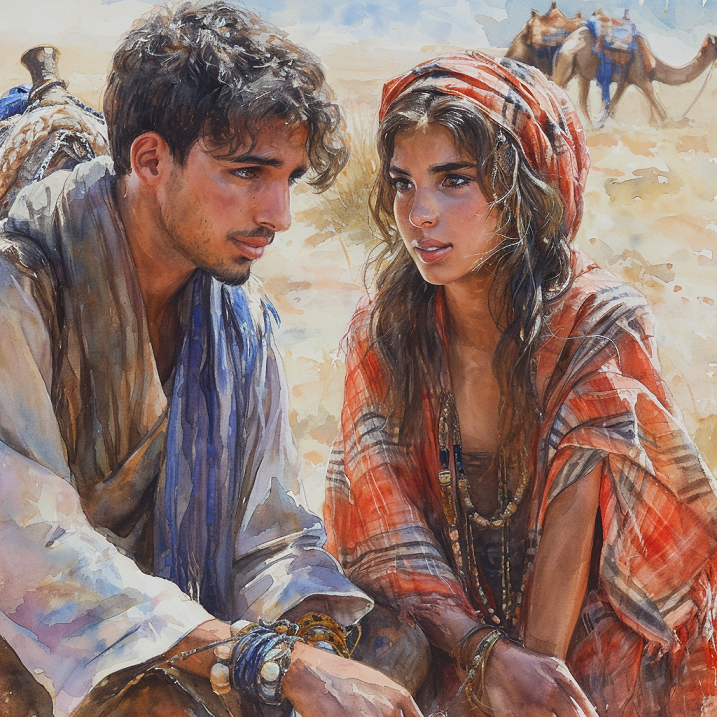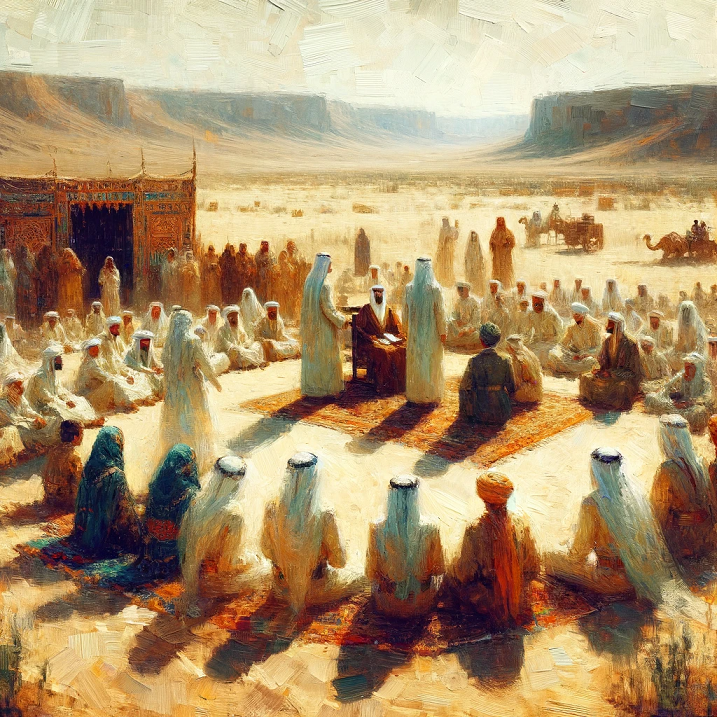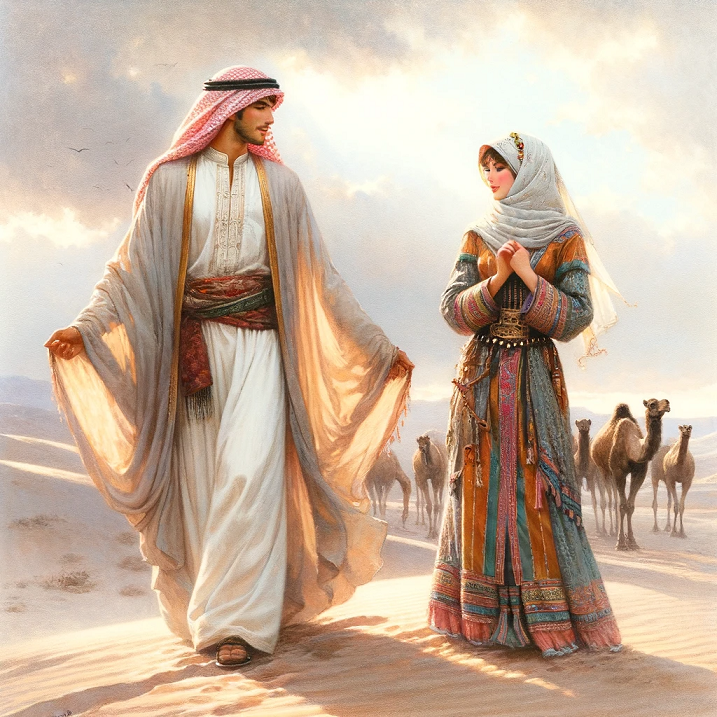In the early 20th century, the Bedouin Arabs of the Arabian Peninsula had crafted a society deeply rooted in traditions and customs, particularly evident in their practices surrounding marriage and divorce. These customs, as chronicled by H.R.P. Dickson in his book, “The Arab Of The Desert”, offer a window into a world where social structures and personal relationships were governed by a complex interplay of laws, societal expectations, and cultural norms. Dickson’s detailed ethnographic account serves as a lens through which we can understand the intricacies of Bedouin life, especially in regions like Kuwait and the broader Arabian landscape.
- Bedouin marriage customs were strictly regulated by tribal norms and hierarchies.
- First-cousin marriages were the norm, with significant societal implications for refusal.
- Divorce in Bedouin society was marked by its simplicity and lack of stigma.
- Women retained the jehaz (bride price) after divorce, ensuring some financial security.
- Regional variations existed in marriage customs across Kuwait and Iraqi tribes.
- Love and emotional bonds played a significant role in Bedouin marriages.
- Polygamy was less common due to economic constraints, leading to more exclusive spousal bonds.
- Love stories within the Bedouin culture illustrated deep emotional connections and societal challenges.
Restrictions in Marriage
In the Bedouin Arab society, as detailed by Dickson, marriage was bound by specific restrictions that reflected the tribe’s values and hierarchical structure. A Badawin, for instance, was prohibited from marrying several close relatives, such as the divorced wife of his son, his son’s widow, his wife’s mother, and notably, his brother’s and sister’s daughters. These restrictions extended to his foster sister, underlining the significance of familial bonds in their social fabric. Additionally, marriages with members of tribes deemed inferior, were frowned upon. This hierarchy within tribal communities underscored the importance of maintaining tribal purity and status.
Societal Expectations and Norms
The societal expectations surrounding marriage were clear and stringent. Upon reaching adulthood, a young Badawin man was anticipated to marry, with a similar expectation placed on women at the onset of puberty. The practice of first-cousin marriages was prevalent and almost an invariable rule, often predetermined by familial arrangements. The right of a man to marry his cousin, or ibn ’am, was so entrenched in their customs that deviation from this norm could lead to severe consequences.
Consequences of Refusing a Cousin
Refusing a marriage to an ibn ’am was a matter of serious contention. Such a refusal could result in the woman being murdered without the perpetrator facing any repercussions, a stark testament to the rigidity of these matrimonial customs. Elopement, though perilous, emerged as a means of escape from this binding tradition, yet it came with its own set of dangers, including potential retribution from the spurned cousin.
Marriage Procedures and Costs
When a marriage was agreed upon, the procedures and costs associated with it were significant. The bride price, or jehaz, varied depending on the man’s status – a commoner or a sheikh. Alongside this financial transaction, the groom was also responsible for providing the bride with clothing and a marriage-bed, essentials for the new life they were to commence together. These practices not only solidified the marriage agreement but also reflected the economic and social standing of the families involved.
The Marriage Ceremony
The actual marriage ceremony, conducted by a muta’awa or a learned religious figure, was a model of simplicity. The ceremony required the mutual consent of both parties, often in the presence of witnesses, underscoring the communal nature of marriage in Bedouin society. Though the bridegroom might not have seen his bride if she wasn’t his cousin, the community’s involvement ensured transparency and adherence to tradition.
Post-Marriage Practices
Following the wedding, consummation took place in a specially pitched tent, symbolising the couple’s new journey together. The entire process, from the marriage ceremony to consummation, was closely observed by the community, reflecting the collective interest in the union’s success and the reinforcement of social bonds through marital alliances.
The Badawin’s love for cohabitation is well known, and as I have said elsewhere, sex is to him the supreme joy of life. Both bride and bridegroom indulge riotously in this honeymoon period. So wildly passionate is their love-making that I have known of a man breaking two of his wife’s ribs on the first night of their marriage.
H.R.P Dickson The Arab of the Desert
Divorce Practices Among the Bedouin
In stark contrast to the intricate customs surrounding marriage, the process of divorce among the Bedouin Arabs was marked by its simplicity and straightforward nature. As Dickson notes, a man could divorce his wife merely by stating his intention to do so three times in the presence of witnesses. This phrase, “Ma aridich,” translated as “I do not want you,” when repeated thrice, was sufficient to dissolve the marriage. This ease of separation speaks volumes about the flexibility and practicality embedded in Bedouin social structures, particularly in handling marital discord.
Financial and Social Implications
Despite the ease with which a marriage could be dissolved, the aftermath of a divorce was not fraught with stigma or financial ruin, especially for the woman. The jehaz, consisting of money, clothes, and the marriage-bed initially provided by the husband, remained with the woman after the divorce. This practice ensured that she had some means of support post-divorce, reflecting a degree of economic foresight and care for the well-being of the separated woman.
Remarriage and Societal Perceptions
The social fabric of the Bedouin tribes did not view divorce negatively. Women, in particular, faced no disgrace and were often quick to remarry. This lack of stigma and the tribe’s acceptance of divorce as a normal part of life allowed for a dynamic social environment where individuals could form new alliances and marriages without enduring lasting social repercussions. This aspect of Bedouin culture starkly contrasts with many contemporary societies where divorce can often carry a significant social stigma.
No disgrace whatsoever clings to divorce, and if the girl is fair, or was the wife of a big shaikh, there is keen competition among the other young men to marry her. This especially is the case if the girl has character and is famed among men.
H.R.P Dickson The Arab of the Desert
Prominent Case Studies
Dickson highlights specific cases that illustrate these norms in action, notably the story of Al Jazi, sister of a paramount Sheikh in 1935. Al Jazi’s multiple marriages, including three times to King ’Abdul ’Aziz al Sa’ud, demonstrate not only the acceptability of remarriage but also the strategic importance of these unions in forming and maintaining alliances within and across tribes. Her story underscores how marital and post-marital practices were intricately woven into the broader tapestry of tribal politics and social standings.
The system means that pretty nearly every woman, by the time she is thirty years old, has had two or three husbands, some as many as seven or eight. Hence there is no spinsterhood among Badawins, and every woman at one time or another experiences the joys of married life. Thus there is no unmarried woman problem, and no prostitution.
H.R.P Dickson The Arab of the Desert
Regional Variations in Marriage Customs
In Kuwait, the customs surrounding marriage displayed unique characteristics that distinguished them from the broader Bedouin practices. Dickson notes a particularly interesting custom: the bridegroom was expected to spend the initial seven days of marriage in the bride’s parents’ house. This tradition, rooted in the concept of easing the bride into her new life, highlights the sensitivity and consideration given to the bride’s emotional well-being. It signifies a form of respect and adaptation to the bride’s comfort and adjustment in her new marital journey.

The negotiation and payment of the jehaz (bride price) in Kuwait town also had its peculiarities. Unlike in other regions where haggling might occur, in Kuwait, if the bridegroom’s party disagreed with the demanded price, they would simply decline without bargaining, indicating a respect for the bride’s value that transcended mere monetary negotiation.
Marriage Customs Among Iraq Tribes
Moving to the Iraq tribes, Dickson illustrates further regional variations in Bedouin marriage customs. The bride’s trousseau in these tribes typically consisted of practical household items, highlighting the emphasis on the domestic role and responsibilities that the bride would assume. Unlike the general Bedouin practice, Iraqi tribal customs did not involve the bride bringing significant assets such as livestock to her husband, debunking some common misconceptions held by outsiders.
The bride price in these tribes, particularly for a sheikh’s daughter, could be substantial, but the practice remained similar in essence to that of other Bedouin tribes, emphasising the importance of familial alliances and social status. Moreover, cousin marriages were as prevalent in Iraq tribes as in other Bedouin societies, with the added complexity of keeping property within the family, especially among the Sa’adun Shaikhs of the Muntafiq. This practice further exemplifies the intertwining of marriage with tribal politics and asset management.
Love and Relationships in Bedouin Society
In the realm of Bedouin relationships, the concept of love, as described by Dickson, was both profound and complex. Contrary to some misconceptions, love as an emotion played a significant role in Bedouin marriages, transcending the practical and economic aspects that often dominated the marital arrangements. Despite the prevalent practice of polygamy, as permitted by their religious beliefs, most Bedouin men typically had only one wife, largely due to economic constraints. This limitation inadvertently fostered a deeper, more exclusive bond between spouses.
Dickson observed that many Bedouin couples displayed a level of affection and trust that equated to the standards of love and commitment seen in Western societies. These emotions were not diluted by the simplicity of divorce laws or the societal acceptance of multiple marriages. Instead, there was a clear understanding and respect for the emotional bond shared between a man and his wife, which often lasted a lifetime, even as they aged and their physical attributes waned
Illustrative Love Stories
To further illustrate the presence and depth of love in Bedouin society, Dickson recounts compelling love stories that he encountered. One such story is of Mutlug ibn Majid, a young man from the Al Shuqair section of the Mutair, whose unrequited love for a maiden led him to a state of madness. This tale not only highlights the intensity of romantic feelings among the Bedouin but also the societal challenges and obstacles that such love could encounter.
In reply to my many questions as to the degree of madness that had overcome the boy, I was told that he would not eat, nor talk, nor recognise anyone. It was said by some in the tribe that it was not the love of the woman that had caused his madness, but that he had walked over a grave during the night by accident, and that a from the grave had seized upon him and possessed him.
H.R.P Dickson The Arab of the Desert

Another poignant story is that of Mutlug al Sur, a dedicated warrior whose love for a girl from his tribe, the Bura’asa, persisted despite initial rejections and the passage of time. His eventual success in winning her over, with the aid of King ’Abdul ’Aziz, showcases the lengths to which a Bedouin man would go for love. It also illustrates the community’s role in facilitating and acknowledging these deep personal connections.
The understanding Bin Sa’ud, than whom no man knows woman better, gave Mutlug a very valuable ’Umaniyah Dhulul (thorough-bred riding camel from Oman), one of his very best. The camel even had a silver ring in her nose to prove her worth. He gave him also a present of Rs.2.oo and several extra-gaudy woman’s garments. “Go now, my son, and win the lady,” said the King, “and tell her ’Abdul ’Aziz himself begs this favour of her, and has sent her of his best.”
H.R.P Dickson The Arab of the Desert
Dickson’s work offers invaluable insights into a world where familial ties, tribal affiliations, and personal relationships were intricately woven into the fabric of daily life. These customs and practices, though rooted in a specific historical and cultural context, provide a broader understanding of the human experience, transcending time and geography.
FAQs:
Q: What were the common restrictions in Bedouin marriage customs?
A: Marriages were restricted among close relatives and with members of certain inferior tribes.
Q: What was the typical practice regarding cousin marriage among the Bedouin?
A: First-cousin marriages were the norm and culturally expected.
Q: How simple was the process of divorce among the Bedouin?
A: Divorce was straightforward, requiring only a verbal declaration by the husband three times.
Q: Did Bedouin women face financial hardships post-divorce?
A: No, women typically retained the jelzdg, providing them with some financial security.
Q: Were there differences in marriage customs across different regions?
A: Yes, notable variations existed, especially between Kuwait and Iraqi tribes.
Q: How significant was love in Bedouin marriages?
A: Love and emotional bonds were significant and deeply valued in Bedouin marriages.
Q: Did economic factors influence polygamy in Bedouin society?
A: Yes, economic constraints often limited men to one wife, fostering exclusive spousal relationships.
Q: Are there any notable love stories from Bedouin culture?
A: Yes, stories like those of Mutlug ibn Majid al A’sga and Mutlug al Sur highlight deep emotional connections.

